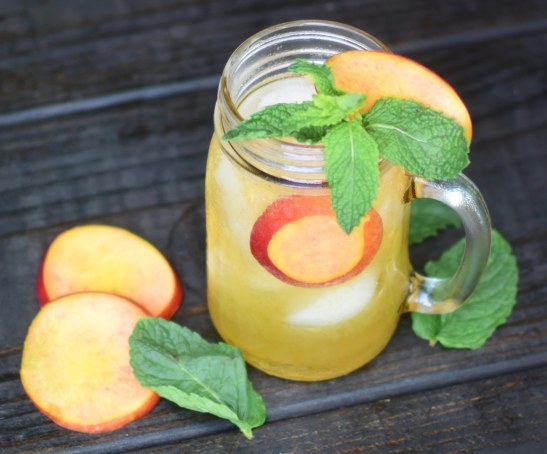Stone Fruit Gin&Ginger
The Stone Fruit Gin&Ginger. Nectarines, mint, gin and ginger beer. The combination can make you feel like Audrey Hepburn window shopping at Tiffany’s. Or, depending on which gin is added, 50 Cent’s Window Shopper. But, hopefully, more like Audrey Hepburn.
A London Dry gin mixes best. By law, London Dry must be:
- 70 percent ABV
- Free of artificial flavors or colorings added after the distillation process
- Equal to or less than .1 gram of sugar per liter
The law of London Dry came about in a roundabout way filled with taxes, regulations and riots. Riots further from “The Dude” Lebowski and closer to the original (17th century) Tea Party antics.
English troops battling the Dutch forces during the Dutch War of Independence, also known as the Eighty Years War, discovered an elixir drunken by Dutch troops before battle that calmed their nerves. They dubbed it “Dutch courage.”
“Dutch courage” is more recognizable today by the name “gin,” which is taken from the Dutch word jenever, meaning juniper.
Gin, like vodka, is unaged and colorless. It uses, like vodka, distilled fermented neutral grains, and then, unlike vodka, infuses aromatics and botanicals including but not limited to juniper, coriander and citrus. Gin can be either compound, or have flavors added after the distillation, or distilled, or have flavors added as a part of the distillation process.
The latter is the case for London Dry. London Dry has a low sugar, juniper forward flavor profile combined with citrus and a mix of countless other herbs depending on the maker. Regardless, London Dry hits like Santa Claus knocked the Christmas tree over.
It wasn’t the juniper (Christmas tree) forward spirit that Englishmen originally fell in love with however. English troops brought a sweeter gin back from their battles in the Eighty Year War. The English government taxed nearly everything except gin and the Gin Craze began, inspiring “Beer Street and Gin Lane,” by William Hogarth in 1751. The government was forced to regulate gin to prevent the population from tipping their bottle back their entire trip to Hades, and the sweeter, cheaper style of gin was put in a strangle hold.
An industrial revolution and 80 or so years later and the column still was born. The London Dry style, lacking the sweet and syrupy characteristics of early gin, followed shortly thereafter.
Even a glossed-over history of London Dry gin hints at why it is best in this cocktail. Whatever gin is used, the combination of mint, nectarine or other stone fruit, gin and ginger beer is not one to be written off.
Ingredients
Method


